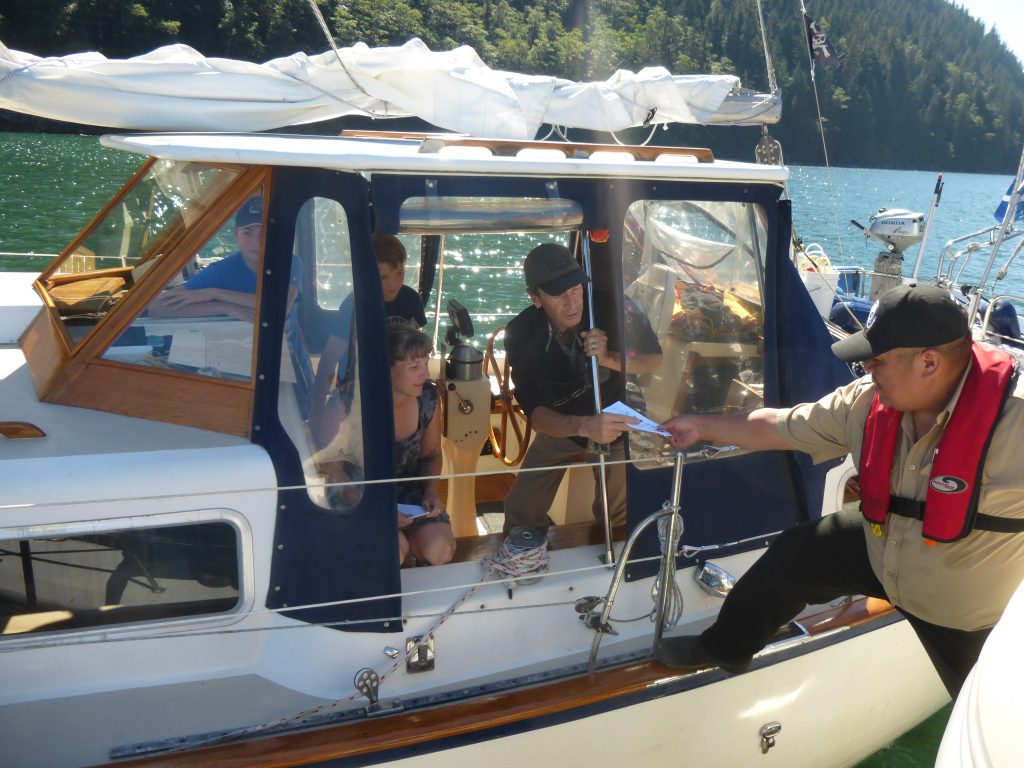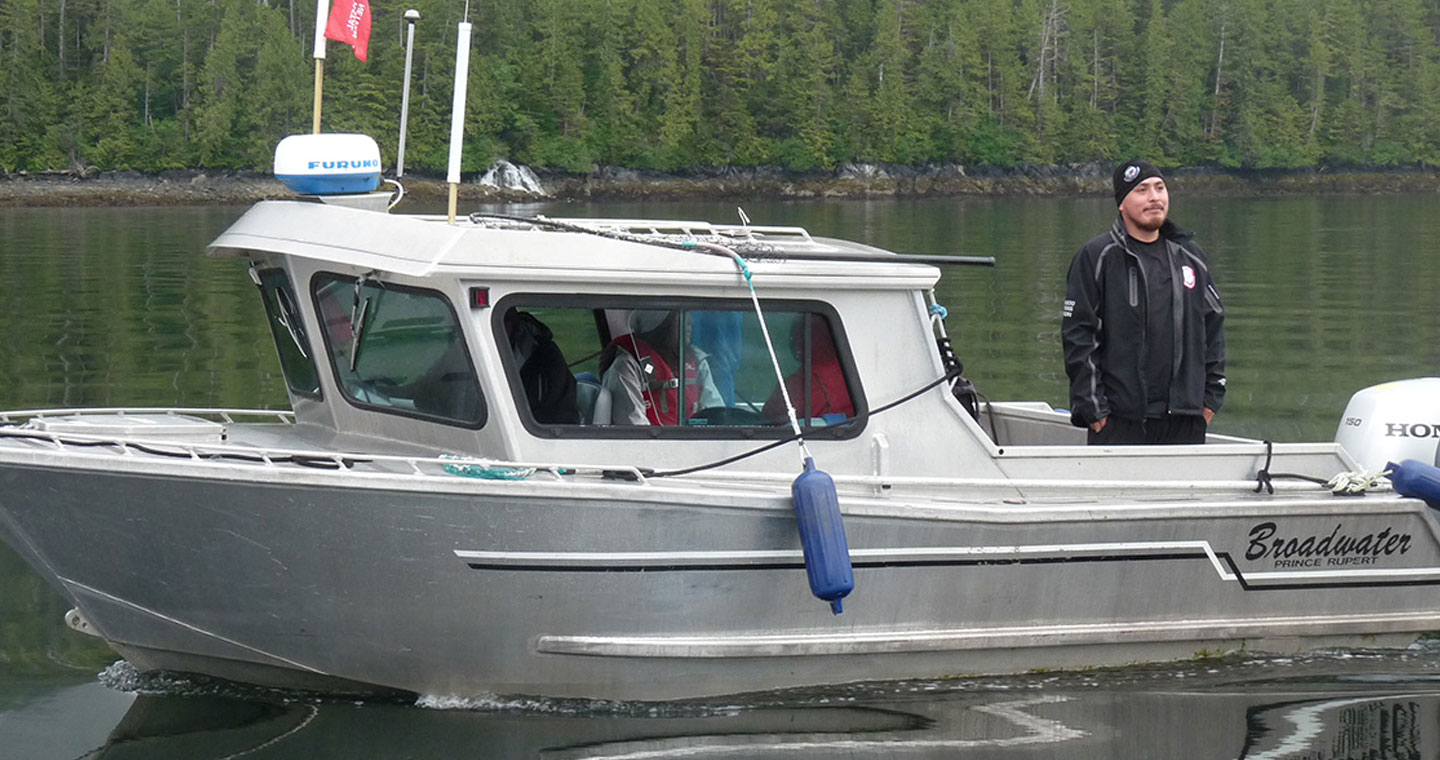
The Great Bear Rainforest Agreements of 2006 and 2009 designated one-third of the region protected. The Pacific Coast continues to be threatened, however, by poaching and trophy hunting, overharvesting and illegal fishing, increased pressure on coastal resources, high-impact tourism, and climate change. The isolated nature of this large area makes monitoring these threats a challenge, and limited federal and provincial resources mean that enforcement staff do not patrol the coast regularly.
The Coastal Stewardship Network (formerly known as the Coastal Guardian Watchmen Network) supports local Guardian Watchmen programs led by First Nations communities on the North and Central Coast, including the Gitga’at, Gwa’sala ‘Nakwaxda’xw, Haida, Haisla, Heiltsuk, Kitasoo/Xai’Xais, Metlakata, Nuxalk, and Wuikinuxv. “These men and women are the eyes and ears in their territories, and there have been indigenous people filling this role since the beginning of time,” says Jana Kotaska, Program Manager, Coastal Stewardship Network. The Guardian Watchmen are hired by their respective nations, and have different backgrounds and experiences with many transferable skills; some were fishermen, others have worked in forestry or tourism. Their individual titles vary—such as resource technician, fisheries guardian, park ranger, or community watchman—but Guardian Watchmen engage in a range of activities that support a common vision: working together to monitor and maintain ecosystem health, and ensure that rules and regulations are followed for the protection of natural and cultural resources.
Local Guardian Watchmen play an integral role in research and monitoring. They assess the health of wildlife on the Pacific Coast, including salmon, grizzly bears, Spirit bears, and birds, and collect data using paper field cards and a handheld mobile device or tablet called a CoastTracker while on patrol. When they return at the end of the day, the data are uploaded into a central database. Guardians and other staff in their stewardship office can access their data for reporting, planning, and decision-making. The Network can also analyze region-wide data and report back to the First Nations on regional trends.
Because local Guardian Watchmen know their territories intimately, they often act as guides for the scientific community, assisting with research on bears, salmon, crab, rockfish, and herring, among other species. They are also able to respond to unexpected events quickly and follow up consistently. “Last year we did tsunami debris cleanup. We’ll probably do it again this year because we’ve noticed that there’s a lot more debris building up now,” says Heiltsuk Fisheries Guardian Randy Carpenter. “We’ve been sending seaweed down to SFU since the earthquake in Japan, testing for radiation.”
Even activities on land affect marine life. “Logging is a major impact because it not only disturbs the land, but it can also disturb the water columns within those territories. Most of them are encroaching pretty close to salmon systems so you have to be able to monitor that,” explains Robert Russ, Fisheries Guardian and Research Diver of the Haida Nation. “The other one is we have a lot of medicinal plants. We want to preserve that because that’s a tradition that’s actually coming back, so it’s very valuable to maintain and preserve what we have there, because if we don’t, what are we going to have for our children?”
In addition to monitoring the ecological health of the region, Guardian Watchmen also play an important role in ensuring rules and regulations are being followed, especially those that are put in place to protect a species with struggling populations. “We went out with the Wuikinuxv Guardians and they basically approach all recreational boaters that are in their territories—there’s actually quite a few in the summer,” explains Kim Hardy, Program Lead, Western Canada, at MakeWay. “They introduce themselves, welcome visitors to their territory, ask them if they have any questions, and make sure they’re safe.” The Pacific Coast’s pristine wilderness attracts outdoor adventurers and tourists alike, but not all are so well-intentioned. The Guardian Watchmen have encountered commercial salmon fishing in closed areas or during closed times, abalone poachers, and trophy hunters. While Guardian Watchmen do not currently have enforcement authority under Canadian law, they monitor compliance under the authorization of their nation’s Chief and Council. They educate resource users and their continual presence on the water encourages compliance.

The Coastal Stewardship Network supports First Nations with local Guardian Watchmen programs by providing opportunities for people to meet and strengthen relationships, share information, and build capacity to carry out individual projects. The network holds an annual conference, monthly conference calls, training programs, workshops, and learning exchanges between communities. “As network staff, we work with all the programs and are able to connect people who are working on similar initiatives and support peer-to-peer learning and sharing. We are also working with non-member First Nations who are currently starting or considering starting a Guardian Watchmen program,” says Kotaska.
In 2012, the network developed a Stewardship Technician Training Program in conjunction with Vancouver Island University, offered in 2013 and 2014. Courses covered monitoring environmental compliance, note-taking and evidence gathering, archaeology and CMT inventory training, parks and protected areas, environmental monitoring, and marine motor servicing. Related resource seminars have also introduced guest speakers from different agencies and organizations including BC Parks, the Ministry of Forests, Lands and Natural Resource Operations, EcoTrust, and WWF. “We have recently expanded the training program to span two years and include two levels of competency. We are seeking funding for the program, which would be open to current or prospective stewardship technicians along the BC Coast from Comox to Prince Rupert and over to Masset over the next five years,” says Kotaska.
“We live here, we breathe here, we drink the water here, we eat the fish, we eat the crabs,” says Alex Chartrand, of the Wuikinuxv Nation. “Who better knows about a creek or a stream than a person who grew up by it, ran around as a small kid or went out with their father or grandfather?” First Nations guardians and watchmen have safeguarded the ecological health of their territories for millennia, ensuring that their people continue to be sustained by the land and sea. “[These are] community members doing it,” says Megan Moody, Nuxalk Stewardship Director. “They live in the community, they know the area, and they want to be there for, well, for their whole life.”
To learn more about the Coastal Stewardship Network and local Guardian Watchmen programs, or to support MakeWay’s work in Pacific Coast communities, contact Kim Hardy.
Robert Russ from the Haida Nation, Alex Chartrand, of the Wuikinuxv Nation, and Megan Moody of the Nuxalk Nation were quoted from “Eyes and Ears on the Land and Sea” a video produced by the Coastal Guardian Watchmen Network (now the Coastal Stewardship Network). View the video here.
